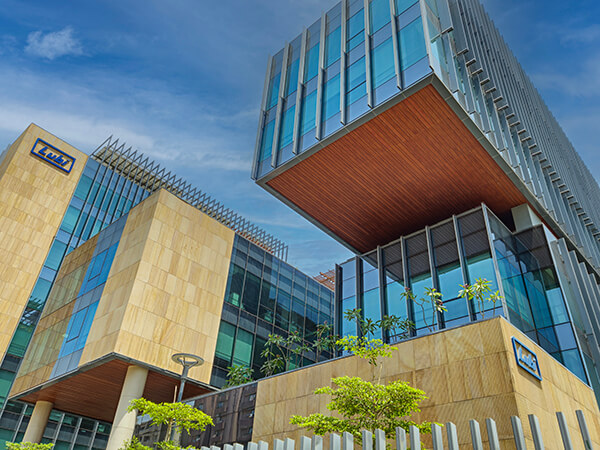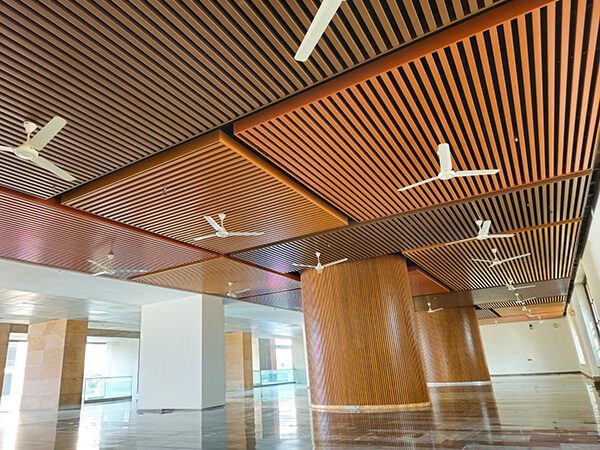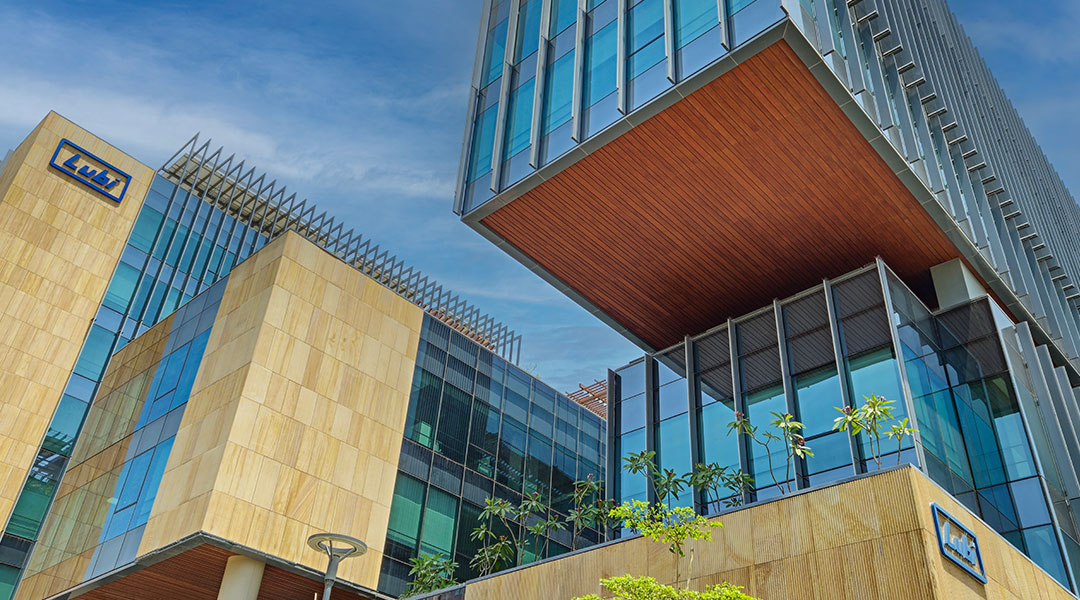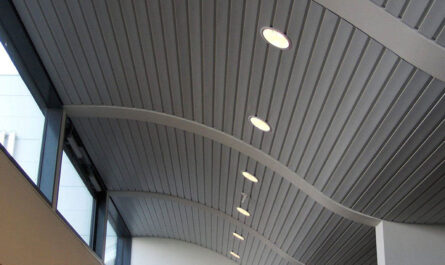The modern office environment has evolved to prioritize both aesthetics and functionality. Wood-finished metal false ceilings represent an innovative solution that combines the visual warmth of natural wood with the practical benefits of metal construction, creating spaces that support both employee wellbeing and organizational goals.
The Rise of Wood-Finished Metal Ceilings in Contemporary Design
Contemporary workplace design increasingly focuses on creating environments that balance professional functionality with comfortable, inviting atmospheres. Wood-finished metal ceilings address this need by offering the biophilic elements of wood textures while maintaining the performance advantages of metal structures.
These innovative ceiling systems use quality metal bases with advanced wood-look finishes that replicate the appearance of natural timber without many of its inherent limitations. This hybrid approach has become increasingly popular as organizations seek to create workspaces that feel both professional and welcoming.
Key Advantages for Office Environments
Merging Visual Appeal with Functional Performance
Wood-finished metal ceilings provide the inviting appearance of natural wood while delivering superior functional benefits. The realistic grain patterns introduce natural elements known to enhance workplace comfort, while the metal construction ensures consistent performance in varying conditions. This makes these systems particularly valuable for organizations aiming to create more comfortable yet professional environments.
Sound Management Solutions
A significant benefit of wood-finished metal ceiling systems is their customizable acoustic performance. These systems can be engineered with specific perforation patterns and acoustic backing materials to address the particular sound management needs of different spaces.
In open office layouts, where noise management is essential for concentration and productivity, properly designed wood-finished metal ceilings with acoustic treatments can significantly reduce ambient noise levels, creating more comfortable working environments without compromising on design aesthetics.
Environmental and Durability Benefits
From a sustainability perspective, wood-finished metal ceilings offer several advantages:
- Conservation of timber resources while maintaining wood aesthetics
- Extended product lifecycle compared to conventional materials
- Metal components that can be recycled at end-of-life
- Reduced maintenance and replacement requirements
These ceilings also provide enhanced fire safety ratings, resistance to moisture damage, and better dimensional stability compared to natural wood alternatives, making them a practical long-term investment.
Innovative Design Approaches
Linear Systems for Contemporary Spaces
Linear wood-look metal planks create clean, directional ceiling patterns that can visually expand spaces or subtly guide movement through an office environment. Available in various dimensions and finish options, these systems work particularly well in:
- Reception and entry areas
- Circulation spaces
- Open-plan work environments
For maximum visual impact, consider aligning linear elements with key architectural features or natural light sources.
Grid Configurations for Classic Appeal
Grid-patterned wood-finished metal ceilings offer a more traditional aesthetic while maintaining modern performance characteristics. These systems typically include:
- Modular panel options in various sizes
- Compatibility with integrated lighting
- Adjustable perforation patterns for acoustic control
This approach is especially effective in executive offices, conference rooms, and spaces where a more structured atmosphere is appropriate.
Curved Elements for Visual Interest
For organizations looking to create distinctive environments, curved wood-finish metal panels provide exciting design possibilities. These systems allow designers to:
- Create flowing ceiling forms that add visual dimension
- Define different functional areas without physical barriers
- Establish focal points above key spaces
These distinctive installations are particularly effective in creative workplaces, collaborative zones, and organizations wishing to differentiate their spaces.
Lighting Integration Strategies
Wood-finished metal ceilings present numerous opportunities for effective lighting integration:
- Recessed linear fixtures that complement ceiling patterns
- Integrated LED systems that highlight wood finishes
- Custom openings for decorative fixtures
Thoughtfully designed lighting not only improves functionality but also enhances the visual qualities of the wood finishes, contributing to a more inviting office atmosphere.
Acoustic Performance Through Perforation
Perforated wood-look metal panels effectively balance aesthetic and acoustic requirements:
- Designer perforation patterns add visual interest
- Acoustic backing materials improve sound absorption properties
- Variable perforation densities allow for acoustic zoning
These solutions are particularly valuable in call centers, collaborative areas, and spaces where speech privacy and noise control are priorities.
Multi-Material Design Integration
Forward-thinking designers often combine wood-finished metal ceiling elements with complementary materials:
- Glass elements that reflect and enhance ceiling patterns
- Exposed structural elements for textural contrast
- Supplementary acoustic solutions for comprehensive sound control
These integrated approaches create visual depth while allowing each material to serve its optimal purpose.
Floating Elements and Focal Installations
Instead of full coverage, suspended wood-look metal elements can create:
- Cloud-like installations above key areas
- Visual designations for meeting or collaborative zones
- Design interest in spaces with complex structural ceilings
This approach delivers acoustic and aesthetic benefits while potentially optimizing material usage.
Nature-Inspired Integrated Designs
Pairing wood-finished metal ceilings with strategic plantings creates enhanced biophilic environments:
- Ceiling designs with openings for hanging plants
- Architectural elements that incorporate planting opportunities
- Lighting designed to support both vegetation and wood aesthetics
Workplace environments incorporating natural elements have been associated with improved employee wellbeing and engagement metrics.
Brand Expression Through Ceiling Design
Wood-finished metal ceiling systems can be customized to strengthen organizational identity:
- Finish selections that complement brand color schemes
- Custom patterns or elements reflecting company identity
- Zoning designs that reflect organizational structure
This approach ensures ceiling design contributes meaningfully to the overall workplace experience.
Implementation Considerations
Planning for Successful Installation
Effective implementation of wood-finished metal ceilings requires careful consideration of:
- Structural support requirements for the chosen system
- Integration with mechanical and electrical systems
- Specific acoustic requirements for different zones
- Coordinated lighting design
Our Real-World Successful Applications
Metalium’s Wood-finished metal ceiling systems have been successfully implemented in various environments:
Technology company headquarters renovations.

A top Manufacturing firm office.

One of the top Educational institutions.

FAQS
What is the typical lifespan of these ceiling systems?
Wood-finished metal ceiling systems generally offer extended service life with proper installation and minimal maintenance requirements.
How do these compare to solid wood ceilings environmentally?
Wood-finished metal ceilings typically use fewer timber resources, offer recyclability advantages, and require less frequent replacement than solid wood alternatives.
Can these systems accommodate building services?
Yes, these systems are designed with various integration options for sprinklers, HVAC, lighting, and other building services.
What acoustic performance can be expected?
Perforated versions with appropriate acoustic backing can provide significant noise reduction properties, helping manage echo, reverberation, and noise transfer in office environments.
Are they suitable for varied environmental conditions?
Unlike natural wood which may be affected by humidity fluctuations, wood-finished metal ceilings typically maintain their dimensional stability across various environmental conditions.
Can existing ceilings be updated with these systems?
In many cases, wood-finished metal ceiling systems can be installed over existing infrastructure or incorporated into partial renovations, depending on specific project conditions.
Conclusion
Wood-finished metal false ceilings represent an effective solution for contemporary office environments seeking to balance aesthetic warmth with practical performance. By combining the visual qualities of wood with the functional benefits of metal, these systems help create workspaces that support both occupant wellbeing and organizational objectives.
As workplace design continues to evolve, integrated ceiling solutions addressing multiple requirements—both visual and functional—will remain important components of commercial interior design. Wood-finished metal systems, with their versatility and performance characteristics, are well-positioned to meet these evolving needs.




